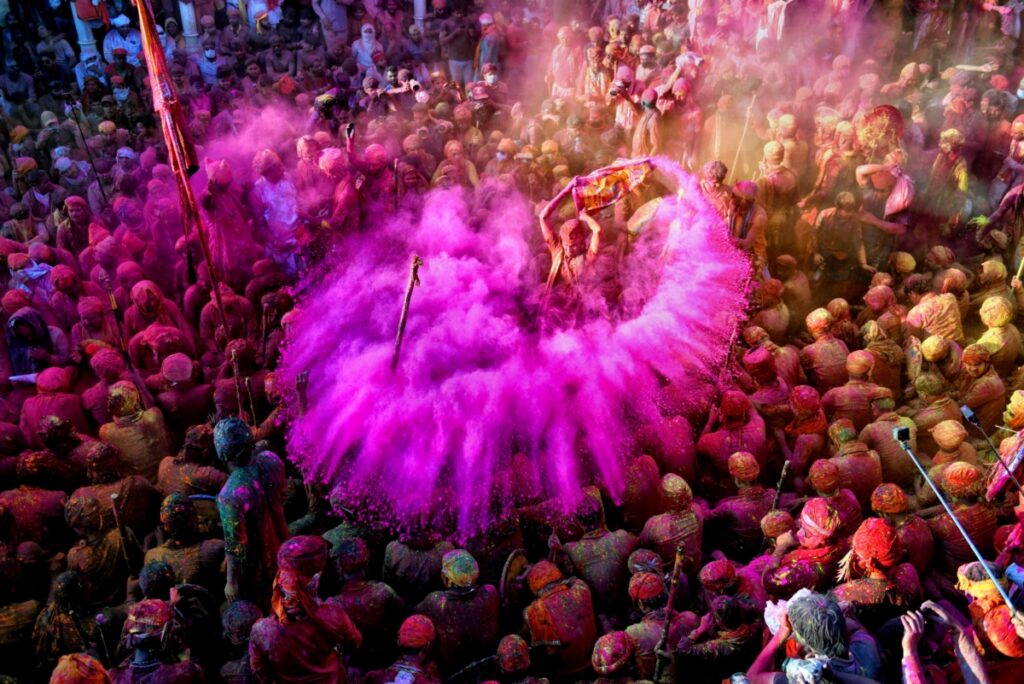Holi, also known as the Festival of Colors or the Festival of Love, is a popular Hindu festival celebrated primarily in India and Nepal. It usually falls in March, marking the arrival of spring and the end of winter. The festival is celebrated with immense enthusiasm and joy, as people, whether Hindus or non-Hindus, engage in throwing colored powders (known as gulal) and water at each other, singing, dancing, and enjoying festive foods and drinks.Holi in India: A Vibrant Traveler’s Guide to the Festival of Colors
Brief History of Holi in India
The history of Holi dates back to ancient Hindu mythology. One prominent legend associated with Holi is the story of Holika and Prahlad, which symbolizes the victory of good over evil. According to this tale, Prahlad, a devout follower of Lord Vishnu, was saved from the wicked intentions of his father’s sister, Holika, who had the power to withstand fire. In an attempt to kill Prahlad, Holika sat in a blazing fire with him on her lap, but due to Prahlad’s unwavering devotion to Lord Vishnu, he emerged unharmed while Holika perished. This event is commemorated during Holi with the ritual of Holika Dahan, where bonfires are lit to symbolize the triumph of virtue over vice.
Another popular legend associated with Holi is the story of Lord Krishna, who is believed to have popularized the playful aspect of applying colors during the festival. Legend has it that Krishna, as a mischievous child, used to playfully douse his friends and beloved Radha with colored water and powders, thus starting the tradition of celebrating Holi with colors.
Customs, Rituals and Traditions
Holi, the Festival of Colors, is rich in rituals and traditions that add depth and significance to the celebrations. Here are some of the key rituals associated with Holi:
Holika Dahan: The festival typically begins with Holika Dahan, also known as Chhoti Holi or Holika Bonfire, on the night before the main day of Holi. Bonfires are lit in public spaces and communities, symbolizing the victory of good over evil and the triumph of Prahlad over Holika. People gather around the bonfire, sing religious hymns, and perform rituals to ward off evil spirits.
Playing with Colors (Rangwali Holi): The hallmark of Holi celebrations is the playful throwing of colored powders and water. On the main day of Holi, people gather in streets, parks, and open spaces to engage in spirited color fights. Friends, family, and even strangers join in the fun, smearing each other with vibrant hues of gulal (colored powders) and spraying colored water using water guns and balloons. This tradition signifies the breaking down of barriers and the fostering of unity and camaraderie.
Thandai and Special Foods: Holi is also a time for indulging in festive treats and drinks. Thandai, a traditional cold drink made with milk, nuts, and spices like saffron and cardamom, is a popular Holi delicacy. Gujiya, a sweet dumpling filled with khoya (milk solids) and dried fruits, is another favorite Holi snack. People exchange these sweets with friends and neighbors as a gesture of goodwill and friendship.
Music and Dance: Holi is incomplete without music and dance. Traditional Holi songs, known as “Holi ke geet” or “Holi songs,” are played during the festivities, setting the mood for revelry and joy. People dance to the rhythm of drums and folk music, adding to the festive atmosphere.
Visiting Friends and Relatives: Holi is also a time for socializing and strengthening bonds with friends and family. People visit each other’s homes, exchange greetings and sweets, and participate in the colorful celebrations together. It’s a time for forgiveness, reconciliation, and spreading love and happiness.
Wearing White: Some communities observe the tradition of wearing white clothes on the day of Holi. This practice emphasizes the colorful nature of the festival, as the vibrant colors stand out vividly against the white backdrop, symbolizing purity and harmony.
These rituals, rooted in mythology and tradition, contribute to making Holi a joyous and meaningful celebration of life, love, and the triumph of good over evil.
The mythological tales, along with these various customs and traditions, have contributed to shaping the rich history and cultural significance of Holi as a festival celebrated with joy, unity, and the spirit of renewal.
Best Places in India to Celebrate Holi
Holi is celebrated with great enthusiasm and fervor across various regions of India. Here are some places in India known for their unique Holi celebrations:
- Mathura and Vrindavan, Uttar Pradesh:
- Mathura, the birthplace of Lord Krishna, and Vrindavan, where he spent his childhood, are immersed in Holi festivities for several days.
- The week-long celebrations include colorful processions, temple rituals, and cultural programs.
- The main day of Holi is marked by the throwing of colors, singing of traditional Holi songs (Holi ke geet), and dancing in the streets.
- The temples in Mathura and Vrindavan are adorned beautifully, and devotees gather to offer prayers and seek blessings.
- Barsana and Nandgaon, Uttar Pradesh:
- Barsana, known for its Radha Rani Temple, celebrates Holi with the famous Lathmar Holi.
- Women of Barsana playfully beat men from Nandgaon with sticks (lathis), symbolizing the playful teasing between Radha and Krishna.
- The men try to defend themselves while being drenched in colored water and powders.
- In Nandgaon, men reciprocate the next day by visiting Barsana and playfully applying colors to the women.
- Jaipur, Rajasthan:
- Jaipur, the capital city of Rajasthan, celebrates Holi with royal grandeur.
- The City Palace hosts a majestic procession led by the royal family, with decorated elephants, horses, and camels.
- Locals and tourists gather to witness the procession, which culminates in the lighting of a bonfire to symbolize the burning of Holika.
- The markets are filled with vibrant colors, traditional sweets, and festive attire, adding to the lively atmosphere.
- Udaipur, Rajasthan:
- Udaipur, known as the City of Lakes, celebrates Holi with traditional fervor and enthusiasm.
- The royal family of Udaipur organizes a grand procession known as the Royal Holi Elephant Procession.
- Decorated elephants, camels, and horses parade through the streets, accompanied by folk dancers, musicians, and drummers.
- Tourists and locals participate in the festivities by playing with colors, dancing, and enjoying local delicacies.
- Anandpur Sahib, Punjab:
- Anandpur Sahib, a holy city for Sikhs, celebrates Holi as Hola Mohalla.
- The festival coincides with Holi and is marked by martial arts displays, mock battles, and processions.
- Nihang Sikhs, dressed in traditional attire, showcase their martial skills and perform daring feats such as horse riding and mock fights.
- The atmosphere is charged with energy and excitement as devotees gather to witness the vibrant festivities.
- Shantiniketan, West Bengal:
- Shantiniketan, founded by Rabindranath Tagore, celebrates Holi as Basanta Utsav with cultural programs, poetry recitations, and performances.
- The festival is marked by the traditional dance of Rabindra Nritya and the singing of Tagore’s compositions.
- Visva-Bharati University organizes colorful processions where students and faculty members dress in traditional attire and sing and dance to the tunes of Tagore’s songs.
- The vibrant atmosphere and artistic fervor attract visitors from all over the country to partake in the festivities and experience the cultural heritage of Bengal.
- Delhi:
- The capital city of India boasts lively Holi celebrations with a cosmopolitan flair.
- Various cultural organizations, residential communities, and social groups organize Holi events and parties across the city.
- Popular areas like Paharganj, Connaught Place, and Hauz Khas witness large gatherings of people playing with colors, dancing to music, and enjoying festive delicacies.
- Tourists and locals alike immerse themselves in the festive spirit, fostering a sense of unity and joy amidst the diverse populace of Delhi.
- Mumbai, Maharashtra:
- Mumbai, the bustling metropolis, celebrates Holi with fervor, reflecting its multicultural ethos.
- Communities across the city organize street parties, cultural events, and Holi-themed gatherings.
- Tourist attractions like Juhu Beach and Marine Drive become vibrant hubs of celebration, with people of all ages reveling in the festive atmosphere.
- Local bands perform live music, while street vendors offer a variety of Holi snacks and sweets, creating a festive ambiance that captures the essence of Mumbai’s dynamic spirit.
Best Things to Do in Holi:
Play with colors: Join the locals in smearing colorful powders and water on each other.
Enjoy festive foods: Indulge in traditional Holi sweets like gujiya, thandai, and malpua.
Attend cultural events: Participate in music and dance performances, street plays, and other cultural activities.
Join processions and parades: Witness colorful processions and parades that are a hallmark of Holi celebrations in many places.
Photography: Capture the vibrant hues and joyous moments of Holi celebrations through your camera lens.

